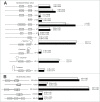A bacterial homolog YciH of eukaryotic translation initiation factor eIF1 regulates stress-related gene expression and is unlikely to be involved in translation initiation fidelity
- PMID: 26177339
- PMCID: PMC4615754
- DOI: 10.1080/15476286.2015.1069464
A bacterial homolog YciH of eukaryotic translation initiation factor eIF1 regulates stress-related gene expression and is unlikely to be involved in translation initiation fidelity
Abstract
YciH is a bacterial protein, homologous to eukaryotic translation initiation factor eIF1. Preceding evidence obtained with the aid of in vitro translation initiation system suggested that it may play a role of a translation initiation factor, ensuring selection against suboptimal initiation complexes. Here we studied the effect of Escherichia coli yciH gene inactivation on translation of model mRNAs. Neither the translation efficiency of leaderless mRNAs, nor mRNAs with non AUG start codons, was found to be affected by YciH in vivo. Comparative proteome analysis revealed that yciH gene knockout leads to a more than fold2- increase in expression of 66 genes and a more than fold2- decrease in the expression of 20 genes. Analysis of these gene sets allowed us to suggest a role of YciH as an inhibitor of translation in a stress response rather than the role of a translation initiation factor.
Keywords: initiation factor; initiation fidelity; translation; yciH.
Figures



References
-
- Pestova TV, Kolupaeva VG, Lomakin IB, Pilipenko EV, Shatsky IN, Agol VI, Hellen CU. Molecular mechanisms of translation initiation in eukaryotes. Proc Natl Acad Sci U S A 2001; 98:7029-36; PMID:11416183; http://dx.doi.org/10.1073/pnas.111145798 - DOI - PMC - PubMed
-
- Hinnebusch AG. The scanning mechanism of eukaryotic translation initiation. Ann Rev Biochem 2014; 83:779-812; PMID:24499181; http://dx.doi.org/10.1146/annurev-biochem-060713-035802 - DOI - PubMed
-
- Milon P, Rodnina MV. Kinetic control of translation initiation in bacteria. Crit Rev Biochem Mol Biol 2012; 47:334-48; PMID:22515367; http://dx.doi.org/10.3109/10409238.2012.678284 - DOI - PubMed
-
- Gualerzi CO, Pon CL. Initiation of mRNA translation in prokaryotes. Biochemistry 1990; 29:5881-9; PMID:2200518; http://dx.doi.org/10.1021/bi00477a001 - DOI - PubMed
-
- Kyrpides NC, Woese CR. Universally conserved translation initiation factors. Proc Natl Acad Sci U S A 1998; 95:224-8; PMID:9419357; http://dx.doi.org/10.1073/pnas.95.1.224 - DOI - PMC - PubMed
Publication types
MeSH terms
Substances
LinkOut - more resources
Full Text Sources
Other Literature Sources
Molecular Biology Databases
